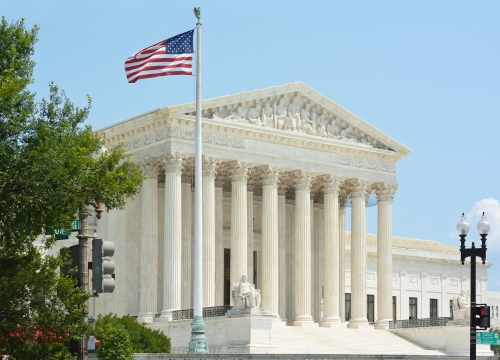Full Federal Circuit Eliminates “Improperly Rigid” Tests for Design Patent Obviousness | Ballard Spahr LLP
Summary
In an en banc decision, the Federal Circuit decided this week that well-established tests for determining design patent obviousness are “improperly rigid,” in violation of U.S. Supreme Court precedent such as KSR v. Teleflex, which established that flexibility is required when determining the obviousness of utility patents. The Federal Circuit gave little guidance on how courts should now determine design patent obviousness, leaving many unanswered questions and creating substantial uncertainty for design patent owners, applicants, and litigants.
The Upshot
- The Federal Circuit decision, effective May 21, 2024, discarded existing tests for design patent obviousness without establishing a clear framework for how design patent obviousness should be determined.
- Given the more flexible approach for establishing obviousness, it will likely now be easier for competitors to develop arguments challenging the validity of existing design patents, and for examiners to reject claimed designs during prosecution.
- The full ramifications of the decision will not be known for years, as the courts and the United States Patent and Trademark Office (USPTO) will need to develop a workable framework for the obviousness analysis.
The Bottom Line
The new flexibility in design patent obviousness arguments creates greater uncertainty for design patent owners and applicants, while providing new opportunities for competitors to bring invalidity challenges or defenses.
One of the best ways to hedge against this increased uncertainty is to continue pursuing multiple embodiments of varying scope for each claimed design, thereby increasing the likelihood that at least one embodiment will be considered nonobvious under whatever analysis framework is established in the future. Attorneys in Ballard Spahr’s Patents Practice will continue monitoring these developments and provide updates.
In a much-anticipated decision in LKQ Corp. v. GM Global Tech Operations LLC, No. 21-2348, slip op. at 15 (Fed. Cir. May 21, 2024) (en banc), the Federal Circuit overruled the decades-old Rosen-Durling test for obviousness in design patents and confirmed that the flexible obviousness analysis applied to utility patents should also be applied to design patents. However, the Federal Circuit did not provide meaningful guidance on how the design patent obviousness analysis should be conducted in practice.
The patent at issue was D797,625, filed by GM Global Technology Operations LLC’s (GM), and claiming a design for a vehicle front fender. LKQ Corporation and Keystone Automotive Industries, Inc. (collectively LKQ) filed a petition for inter partes review (IPR) at the Patent Trial and Appeal Board (PTAB) challenging the validity of the patent. The PTAB agreed with GM, holding LKQ did not establish that the primary cited reference anticipated the claimed design under 35 U.S.C. § 102. With respect to obviousness, the PTAB applied the Rosen-Durling test and found the primary cited reference did not create “basically the same” visual impression as the claimed design. A Federal Circuit panel decision upheld the PTAB’s decision and the full Federal Circuit granted en banc rehearing.
The Rosen-Durling test is based on a 1982 United States Court of Customs and Patent Appeals decision in In re Rosen and a 1996 Federal Circuit decision in Durling v. Spectrum Furniture Company. The Rosen-Durling test, which has been used consistently for nearly 30 years, required that to find a design claim obvious, there must first be an earlier design that has “basically the same” visual impression as the patented design. The next step of the test is to analyze whether it would have been obvious for a designer to arrive at the claimed design by modifying the earlier design through the use of additional designs that are “so related” to the earlier design that the appearance of features in one suggests using them in the other.
The LKQ decision holds the prior Rosen-Durling test is “improperly rigid.” Rather, the Federal Circuit said the more flexible obviousness test for utility patents should apply to design patents, as well. In particular, Judge Stoll, writing for the court, held the “basically the same” and “so related” tests are both inconsistent with Supreme Court precedent such as the 2007 holding in KSR v. Teleflex, which rejected a rigid obviousness test for utility patents. Further, the Federal Circuit held the four-factor test for obviousness laid out in the 1966 Supreme Court decision in Graham v. Deere should also apply to design patents.
At the USPTO, the LKQ decision now increases an examiner’s discretion to reject design applications on obviousness grounds. In litigation, it makes available a wider range of arguments for invalidation. Specifically, the decision shifts the obviousness inquiry from requiring a relatively high degree of similarity between the primary reference and the claimed design to a more comprehensive assessment of the reference from the point of view of the ordinary designer.
The decision reinterprets existing law and thus takes effect immediately, applying not only to issued design patents but also to pending design patent applications. However, because existing case law and USPTO examination procedures have generally followed the discarded Rosen-Durling test, patent applicants and owners will need to monitor future court decisions and USPTO procedures for a new obviousness analysis framework.
In the meantime, applicants should continue to pursue multiple embodiments of varying scope to hedge against this increased uncertainty and increase the likelihood that at least one embodiment will survive future rejections or validity challenges.






